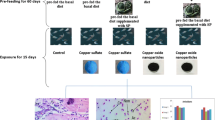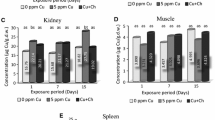Abstract
Copper accumulation in the gill, liver, kidney, spleen, and muscle tissues of Oreochromis niloticus was determined after exposing the fish to 10, 50, and 100 μg Cu/L applied as copper sulphate (CuSO4) and copper oxide nanoparticles (CuO NPs) after 1, 7, and 15 days. Changes in the liver SOD, CAT, and GPx activities influenced by this accumulation were also studied. No mortality was observed during the experiments. Copper levels increased in the gill, liver, kidney, and spleen tissues of O. niloticus compared to control when exposed to both CuSO4 and CuO NPs, whereas no accumulation was detected in muscle tissue at the end of the exposure period. Highest accumulation of copper was observed in the order of the liver, kidney, spleen, and gill tissues, respectively. SOD, CAT, and GPx activities increased in the liver tissue at the end of the exposure period. Overall, CuO NPs are more effective than CuSO4 in terms of tissue accumulation and liver enzyme activities.







Similar content being viewed by others
References
Abdel-Khalek, A. A., Kadry, M. A. M., Badran, S. R., & Marie, M. S. (2015). Comparative toxicity of copper oxide bulk and nano particles in Nile Tilapia; Oreochromis niloticus: biochemical and oxidative stress. Journal of Basic and Applied Biology, 72, 43–57.
Abdel-Tawwab, M., Mousa, M. A. A., Ahmad, M. H., & Sakr, S. F. M. (2007). The use of calcium pre-exposure as a protective agent against environmental copper toxicity for juvenile Nile Tilapia, Oreochromis niloticus (L.). Aquaculture, 264(1–4), 236–246.
Aitken, R. J., Creely, K. S., & Tran, C. L. (2004). Nanoparticles: an occupational hygiene review (p. 91). Suffolk: Health and Safety Executive.
Al-Bairuty, G. A., Shaw, B. J., Handy, R. D., & Henry, T. B. (2013). Histopathological effects of waterborne copper nanoparticles and copper sulphate on the organs of rainbow trout (Oncorhynchus mykiss). Aquatic Toxicology, 126, 104–115.
Asagba, S. A., Eriyamremu, G. E., & Igberaese, M. E. (2008). Bioaccumulation of cadmium and its biochemical effect on selected tissues of the catfish (Clarias gariepinus). Fish Physiology and Biochemistry, 34, 61–69.
Aschberger, K., Micheletti, C., Sokull-Kluttgen, B., & Christensen, F. M. (2011). Analysis of currently available data for characterising the risk of engineered nanomaterials to the environment and human health lessons learned from four case studies. Environment International, 37(6), 1143–1156.
Ateş, M., Dugo, M. A., Demir, V., Arslan, Z., & Tchounwou, P. B. (2014). Effect of copper oxide nanoparticles to sheepshead minnow (Cyprinodon variegatus) at different salinities. Digest Journal of Nanomaterials and Biostructures., 9(1), 369–377.
Bainy, A. C. D., Saito, E., Carvalho, P. S. M., & Junqueıra, V. B. C. (1996). Oxidative stress in gill, erythrocytes, liver and kidney of Nile Tilapia (Oreochromis niloticus) from a polluted site. Aquatic Toxicology, 34, 151–162.
Bradford, M. (1976). A rapid and sensitive method for the quantitation of microgram quantities of protein utilizing the principle of protein-dye binding. Analytical Biochemistry, 72, 248–254.
Bystrzejewska-Piotrowska, G., Golimowski, J., & Urban, P. L. (2009). Nanoparticles: their potential toxicity, waste and environmental management. Waste Management, 29, 2587–2595.
Chen, C., Meng, H., Xing, G., Chen, C., Zhao, Y., & Jia, G. (2006). Acute toxicological effects of copper nanoparticles in vivo. Toxicology Letters, 163, 109–120.
Cicik, B. (2003). Bakır-Çinko Etkileşiminin Sazan (Cyprinus carpio)’ın Karaciğer, Solungaç ve Kas Dokularındaki Metal Birikimi Üzerine Etkileri. Ekoloji, 12(48), 32–36.
Cousins, R. J. (1985). Absorbtion, transport and hepatic metabolism of copper and zinc: special reference to metallothionein and ceruloplasmin. Physiological Reviews, 65(2), 238–309.
Daoud, A., Saud, A., Sudhir, K., Maqusood, A., & Maqsood, A. S. (2012). Oxidative stress and genotoxic effect of zinc oxide nanoparticles in freshwater snail Lymnaea luteola L. Aquatic Toxicology, 124(125), 83–90.
Dautremepuits, C., Paris-Palacios, S., Betoulle, S., & Vernet, G. (2004). Modulation in hepatic and head kidney parameters of carp (Cyprinus carpio L.) induced by copper and chitosan. Comparative Biochemistry and Physiology Part C, 137, 325–333.
De Conto Cinier, C., Ramel, M. P., Faure, R., Garin, D., & Bouvet, Y. (1999). Kinetics of Cd accumulation and elimination in carp Cyprinus carpio tissues. Comparative Biochemistry and Physiology, Part C, 122, 345–352.
Deb, S.C., Fukushima, T. (1999). Metals in aquatic ecosystems: Mechanisms of uptake, accumulation and release ecotoxicological perspective. International Journal of Environmental Studies, 56(3), 385–417.
Doyotte, A., Cossu, C., Jacquin, M. C., Babut, M., & Vasseur, R. (1997). Antioxidant enzymes, glutathione and lipid peroxidation as relevant biomarkers of experimental or field exposure in the gills and the digestive gland of the freshwater bivalve Unio turnidus. Aquatic Toxicology, 39, 93–110.
Duran, S., Tunçsoy, M., Yesilbudak, B., Ay, O., Cicik, B., & Erdem, C. (2015). Metal accumulation in various tissues of Clarias gariepinus exposed to copper, zinc, cadmium and lead singly and in mixture. Fresenius Environmental Bulletin, 24(12C), 4738–4742.
Fahmy, B., & Cormier, S. A. (2009). Copper oxide nanoparticles induce oxidative stress and cytotoxicity in airway epithelial cells. Toxicology In Vitro, 23, 1365–1371.
Federici, G., Shaw, B. J., & Handy, R. D. (2007). Toxicity of titanium dioxide nanoparticles to rainbow trout (Oncorhynchus mykiss): gill injury, oxidative stress, and other physiological effects. Aquatic Toxicology, 84(4), 415–430.
Fu, P. P., Xia, Q., Hwang, H. M., Ray, P. C., & Yu, H. (2014). Mechanisms of nanotoxicity: generation of reactive oxygen species. Journal of Food and Drug Analysis, 22, 64–75.
Galvez, F., Nebb, N., Hogstrand, C., & Wood, C. M. (1998). Zinc binding to the gills of rainbow trout: the effect of long-term exposure to sublethal zinc. Journal of Fish Biology, 52, 1089–1104.
Gioda, C. R., Lissner, L. A., Pretto, A., Rocha, J. B. T., Schetinger, M. R. C., Neto, J. R., Morsch, V. M., & Loro, V. L. (2007). Exposure to sublethal concentrations of Zn (II) and Cu (II) changes biochemical parameters in Leporinus obtusidens. Chemosphere, 69, 170–175.
Gomes, T., Pinheiro, J. P., Cancio, I., Pereira, C. G., Cardoso, C., & Bebianno, M. J. (2011). Effects of copper nanoparticles exposure in the mussel Mytilus galloprovincialis. Environmental Sciences and Technology, 45, 9356–9362.
Greenwald, R. A. (1985). Handbook of methods for oxygen radical research (p. 447). Boca Raton: CRC Press.
Griffitt, R. J., Weil, R., Hyndman, K. A., Denslow, N. D., Powers, K., Taylor, D., & Barber, D. S. (2007). Exposure to copper nanoparticles causes gill injury and acute lethality in zebrafish (Danio rerio). Environmental Science & Technology, 41, 8178–8186.
Griffitt, R. J., Hyndman, K., Denslow, N. D., & Barber, D. S. (2009). Comparison of molecular and histological changes in zebrafish gills exposed to metallic nanoparticles. Toxicological Sciences, 107(2), 404–415.
Hao, L., Chen, L., Hao, J., & Zhong, N. (2013). Bioaccumulation and sub-acute toxicity of zinc oxide nanoparticles in juvenile carp (Cyprinus carpio): a comparative study with its bulk counterparts. Ecotoxicology and Environmental Safety, 91, 52–60.
Heath, A. G. (1995). Water pollution and fish physiology (p. 245). Florida: CRC Press.
Hollis, L., McGeer, J. C., McDonald, D. G., & Wood, C. M. (1999). Cadmium accumulation, gill Cd binding, acclimation and physiological effects during long term sublethal cd exposure in rainbow trout. Aquatic Toxicology, 46, 101–119.
Hollis, L., Hogstrand, C., & Wood, C. M. (2001). Tissue-specific cadmium accumulation, metallothionein induction, and tissue zinc and copper levels during chronic sublethal Cd exposure in juvenile rainbow trout. Archives of Environmental Contamination and Toxicology, 41, 468–474.
Johari, S. A., Kalbassi, M. R., Yu, I. J., & Lee, J. H. (2015). Chronic effect of waterborne silver nanoparticles on rainbow trout (Oncorhynchus mykiss): histopathology and bioaccumulation. Comparative Clinical Pathology, 5, 995–1007.
Kargın, F. (1996). Seasonal changes in levels of heavy metals in tissues of Mullus barbatus and Sparus aurata collected from Iskenderun Gulf (Turkey). Water, Air and Soil Pollution, 90, 557–562.
Kargın, F., & Erdem, C. (1991). Cyprinus carpio’da Bakırın Karaciğer, Dalak, Mide, Bağırsak, Solungaç ve Kas Dokularındaki Birikimi. Turkish Journal of Zoology, 15, 306–314.
Kosai, P., Jiraungkoorskul, W., Thammasunthorn, T., & Jiraungkoorskul, K. (2009). Reduction of copper-induced histopathological alterations by calcium exposure in Nile Tilapia (Oreochromis niloticus). Toxicology Mechanisms and Methods, 19(6–7), 461–467.
Kumar, O., Sugendran, K., & Vijayaraghavan, R. (2003). Oxidative stress associated hepatic and renal toxicity induced by ricin in mice. Toxicology, 41, 333–338.
Lawrence, R. A., & Burk, R. F. (1976). Glutathione peroxidase activity in selenium deficient rat liver. Biochemical and Biophysical Research Communications, 71(4), 952–958.
Ma, L. L., Liu, J., Li, N., Wang, J., Duan, Y. M., Yan, J. Y., Liu, H. T., Wang, H., & Hong, F. S. (2010). Oxidative stress in the brain of mice caused by translocated nanoparticulate TiO2 delivered to the abdominal cavity. Biomaterials, 31, 99–105.
McCord, J. M., & Fridovich, I. (1969). Superoxide dismutase: an enzymic function for erythrocuprein (hemocuprein). Journal of Biological Chemistry, 244(22), 6049–6055.
McGeer, J. C., Szebedinszky, C., McDonald, D. G., & Wood, C. M. (2000). Effect of chronic sublethal exposure to waterborne Cu, Cd or Zn in rainbow trout 2: tissue specific metal accumulation. Aquatic Toxicology, 50, 245–256.
Muramoto, S. (1983). Elimination of copper from Cu-contaminated fish by long-term exposure to EDTA and freshwater. Journal of Environmental Science Health, 18A(3), 455–461.
Prousek, J. (2007). Fenton chemistry in biology and medicine. Pure and Applied Chemistry, 79, 2325–2338.
Ramsden, C. S., Smith, T. J., Shaw, B. S., & Handy, R. D. (2009). Dietary exposure to titanium dioxide nanoparticles in rainbow trout, (Oncorhynchus mykiss): no effect on growth, but subtle biochemical disturbances in the brain. Ecotoxicology, 18, 939–951.
Sakai, N., Matsui, Y., Nakayama, A., Tsuda, A., & Yoneda, M. (2011). Functional-dependent and size-dependent uptake of nanoparticles in PC12. Journal of Physics, 304, 1.
Schrand, A. M., Rahman, M. F., Hussain, S. M., Schlager, J. J., Smith, D. A., & Syed, A. F. (2010). Metal-based nanoparticles and their toxicity assessment. Wiley Interdisciplinary Reviews—Nanomedicine and Nanobiotechnology, 2(5), 544–568.
Scown, T. M., Van Aerle, R., Johnston, B. D., Cumberland, S., Lead, J. R., Owen, R., & Tyler, C. R. (2009). High doses of intravenously administered titanium dioxide nanoparticles accumulate in the kidneys of rainbow trout but with no observable impairment of renal function. Toxicological Sciences, 109, 372–380.
Shaw, B. J., Al-Baurity, G., & Handy, R. D. (2012). Effects of waterborne copper nanoparticles and copper sulphate on rainbow trout, (Oncorhynchus mykiss): physiology and accumulation. Aquatic Toxicology, 116(117), 90–101.
Tunçsoy, M., & Erdem, C. (2014). Accumulation of copper, zinc and cadmium in liver, gill and muscle tissues of Oreochromis niloticus exposed to these metals separately and in mixture. Fresenius Environmental Bulletin, 23(5), 1143–1149.
Valavanidis, A., Vlahogianni, T., Dassenakis, M., & Scoullos, M. (2006). Molecular biomarkers of oxidative stress in aquatic organisms in relation to toxic environmental pollutants. Ecotoxicology and Environmental Safety, 64, 178–189.
Viarengo, A. (1985). Biochemical effects of trace metals. Marine Pollution Bulletin, 16(4), 153–158.
Villarreal, F. D., Das, G. K., Abid, A., Kennedy, M., & Kultz, D. (2014). Sublethal effects of CuO nanoparticles on Mozambique Tilapia (Oreochromis mossambicus) are modulated by environmental salinity. PLoS One, 9(2), 1–15.
Wang, T., Long, X., Cheng, Y., Liu, Z., & Yan, S. (2015). A comparison effect of copper nanoparticles versus copper sulphate on juvenile Epinephelus coioides: growth parameters, digestive enzymes, body composition, and histology as biomarkers. International Journal of Genomics, 215, 1–10.
Xiong, D., Fang, T., Yu, L., Sima, X., & Zhu, W. (2011). Effects of nano-scale TiO2, ZnO and their bulk counterparts on zebrafish: acute toxicity, oxidative stress and oxidative damage. Science of the Total Environment, 409, 1444–1452.
Acknowledgements
This work was supported by the Çukurova University, Scientific Research Projects Coordination Unit and The Scientific and Technological Research Council of Turkey. We also would like to acknowledge Prof. Dr. Maria João Bebianno, Asst. Prof. Dr. Margarida Ribau Teixeira, Dr. Tânia Gomes, and Vânia Sousa.
Author information
Authors and Affiliations
Corresponding author
Rights and permissions
About this article
Cite this article
Tunçsoy, M., Erdem, C. Copper Accumulation in Tissues of Oreochromis niloticus Exposed to Copper Oxide Nanoparticles and Copper Sulphate with Their Effect on Antioxidant Enzyme Activities in Liver. Water Air Soil Pollut 229, 269 (2018). https://doi.org/10.1007/s11270-018-3913-z
Received:
Accepted:
Published:
DOI: https://doi.org/10.1007/s11270-018-3913-z




